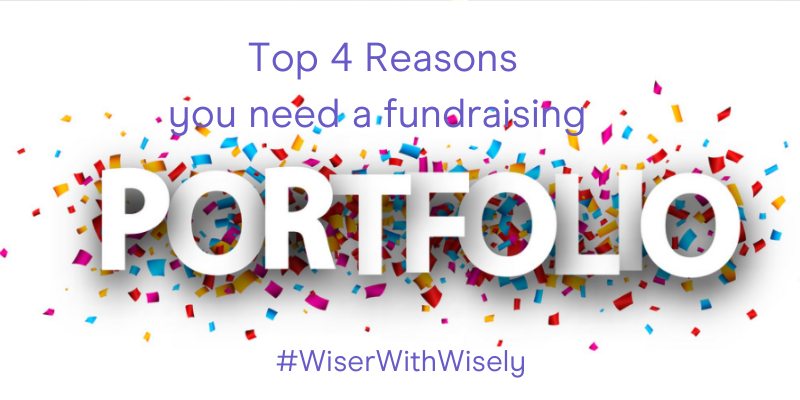
Last week we went over the reasons why a fundraising portfolio is best managed in a nonprofit management software like Wisely and not Excel. This may have left you wondering “why do I need a fundraising portfolio at all?” This post is here to answer that question!
A fundraising portfolio is how your fundraisers, and your revenue development team as a whole, will manage the information related to your mid-level, major gift, planned giving donors, and your prospects. A fundraising portfolio is a requirement for a successful moves management strategy.
Your fundraising portfolio holds important information like
- Donors with outstanding pledges
- Recent giving history to inform future askes
- Goal setting and expected revenue information
- Notes about donor journeys
- Information about who is ready to be asked again and who needs to be stewarded
There are many reasons you need a fundraising portfolio. Here are Wisely’s Top Four!
1. Moves Management
An effective fundraising portfolio helps you stick to a moves management strategy without missing a step. Please note the use of effective in the previous sentence! In order to have strong moves management in your portfolio, you need to be using a nonprofit software-based system and not a manual, makeshift system like Excel.
Here’s how a fundraising portfolio helps your fundraising team with moves management:
- Never miss a step with reminders and notes about each donor’s unique journey with your nonprofit.
- Identify prospects from other areas of giving at your nonprofit, like your annual program or event attendees, and add them to your fundraising portfolio to build a deeper relationship with them.
- Manage donor lifecycles and know when a donor is ready to be asked again with a fundraising portfolio that supports moves management.
- Steward your donors appropriately and never miss a deadline for a stewardship or impact report. Happy donors are more likely to give to your nonprofit in the future!
Make sure the system that your team is using for your portfolio is set up to help you plan and keep track of your moves management strategy!
2. Track Progress towards Goals
As a fundraiser, there is nothing worse than not knowing where you stand against your goal for the year. It is vital for successful fundraisers to know how much revenue they’ve brought in, not just realized revenue, but also expected revenue from donors who have pledged or have deferred their giving in other ways.
Tracking revenue progress with a fundraising portfolio helps fundraisers be more successful.
- Track realized and expected revenue so you know how your team is progressing towards the goal for the year and how much revenue needs to be raised to fill the gap.
- Stay on top of pledges with reminders for overdue pledges and pledge payments that are due soon so you can follow up with these donors to turn this expected revenue into realized revenue.
- Track goal progress to take the guesswork out of knowing whether or not you’ll meet your revenue goal and see where you need to focus to make up the difference.
- More accurate future business planning based on revenue trends throughout the year and careful management of multi-year pledges.
3. Gain Efficiency with Centralized Data
A fundraising portfolio helps you by centralizing donors’ information in one place where your whole fundraising team can find the information they need. This creates efficiency, especially if you’re keeping your fundraising portfolio in a nonprofit fundraising software that everyone can access and update.
Centralizing your data makes your fundraising more efficient, and by extension more effective.
- Future-proofing your data against turnover. It will be easy for new fundraisers to access donor information and notes from former staff.
- See the big picture with everything in one place, it’s easy for team leaders to check progress and spot areas of concern.
- Ease of access, fundraisers can access their fundraising portfolio easily, see the information they need, and make updates in one central location.
- Bonus: centralized data offers better security from storing your donor data in one centralized location rather than on the hard drives and in the inboxes of multiple staff members.
4. Priority Mapping
One of the important things that a fundraising portfolio helps you accomplish is planning your fundraising priorities. With all of your fundraising and donor information in one place, you can spot trends, keep an eye on expected revenue, and decide which donors to focus on.
- Determine if you have enough prospects to meet your revenue goals for the year, if not add more qualified prospects to your portfolio.
- Prospect tiers in your portfolio inform where fundraisers should focus their efforts to meet goals.
- Donor notes and interests will let your fundraising team know the specific philanthropic interests of your prospects and donors so your fundraisers can present the right ask.
- Use expected revenue values for each prospect and donor to track fundraising progress towards your goal, including revenue that is not yet realized.
Now that you know what a fundraising portfolio can do for your team, and why it’s important next time we’ll be going into specifics on how Wisely can help you manage your portfolio. It has a lot of great tools and features, like AI, to help your fundraising team succeed.